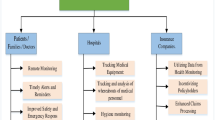Abstract
Because of development of IT and emergence of new hybrid converged services, there have been increasing uses of smart device in wellness services. The wellness services on smart device use personal information to provide user-centric services considering user habits and preferences. Because personal information is so critical and have potential which unauthorized users misuse, it is a need to manage and control the authority in systems and devices for secure services. In this paper, we propose a rhythm-based access control system for secure wellness services. A role is assigned to a user by multiple users’ different rhythm in a smart device and the only predefined service based on the role can be served. In addition, the system grants access authority and provides secure wellness service through enhanced authentication using the uniqueness of user’s rhythm.






Similar content being viewed by others
References
Lee N, Kwon O (2015) A privacy-aware feature selection method for solving the personalization-privacy paradox in mobile wellness healthcare services. Expert Syst Appl 42(5):2764–2771
Sharma GM, Bhaskar P (2015) Trusted and secure clustering in mobile pervasive environment. Human-centric Compu Inf Sci 5(32)
Karnan M, Akila M, Krishnaraj N (2011) Biometric personal authentication using keystroke dynamics: A review. Appl Soft Comput 11(2):1565–1573
Goode A (2010) Managing mobile security: How are we doing? Netw Secur 2010(2):12–15
Dahane A, Berrached N-E, Loukil A (2015) A virtual laboratory to practice mobile wireless sensor networks: a case study on energy efficient and safe weighted clustering algorithm. J Inf Process Syst 11(2):205–228
Lee JD, Jeong Y-S, Park Jong H (2014) A rhythm-based authentication scheme for smart media devices. Sci World J Article ID. 781014, 2014:9
Sandhu Ravi S, Coyne Edward J, Feinstein Hal L, Youman Charles E (1996) Role-based access control models. Computer 29(02):38–47
Ni Q, Bertino E, Lobo J, Brodie C, Karat C-M, Karat J, Trombeta A (2010) Privacy-aware role-based access control. ACM Trans Inf System Secur Article. 24, 13(3):1–31
Matthew MJ, Ahamad M (2001) Generalized role-based access control. In: 21st International Conference on Distributed Computing Systems, pp 391–398
Oh S, Park S (2000) Task-role based access control (T-RBAC): an improved access control model for enterprise environment. Database Expert Sys Appl 264–273
Plump CM, Ketchen DJ Jr (2013) Paving a road to well? How the legal pitfalls of wellness programs can harm organizational performance. Bus Horiz 56(3):261–269
Salamati F, Pasek ZJ (2014) Personal wellness: complex and elusive product and distributed self-services. In: Proceedings of the 6th CIRP conference on industrial product-service systems, vol 16, pp 283–288
Joo JW, Lee JK, Park JH (2015) Security considerations for a connected car. J Converg 6(2):1–9
Choi J, Sung W, Choi C, Kim P (2015) Personal information leakage detection method using the inference-based access control model on the Android platform. Pervasive Mobile Comput 24:138–149
Rizvi S, Mitchell J (2015) A semi-distributed access control management scheme for securing cloud environment, In: 2015 IEEE 8th international conference on cloud computing, pp 501–507
Leitner M, Rinderle-Ma, Mangler J (2011) AW-RBAC: access control in adaptive workflow systems. In: 2011 sixth international conference on availability, reliability and security (ARES), pp 27–34
Narayanan HAJ, Güneş MH (2011) Ensuring access control in cloud provisioned healthcare systems. In: Consumer communications and networking conference (CCNC), pp 247–251
Ruj S, Stojmenovic M, Nayak A (2012) Privacy preserving access control with authentication for securing data in clouds. In: 12th IEEE/ACM international symposium on cluster, cloud and grid computing, pp 556–563
Ni X, Yang Z, Bai X, Champion AC, Xuan D (2009) DiffUser: differentiated user access control on smartphones. In: IEEE 6th international conference on mobile adhoc and sensor systems (MASS’09), pp 1012–1017
Liu C-L (2014) Cloud service access control system based on ontologies. Adv Eng Softw 69:26–36
Acknowledgments
This research was supported by the MSIP (Ministry of Science, ICT and Future Planning), Korea, under the C-ITRC (Convergence Information Technology Research Center) (IITP-2015-H8601-15-1009) supervised by the IITP (Institute for Information and communications Technology Promotion). In addition, this research was supported by the MSIP (Ministry of Science, ICT and Future Planning), Korea, under the ITRC (Information Technology Research Center) support program (IITP-2015-H8501-15-1014) supervised by the IITP (Institute for Information and communications Technology Promotion).
Author information
Authors and Affiliations
Corresponding author
Rights and permissions
About this article
Cite this article
Im, H., Lee, J.K. & Park, J.H. A rhythm-based access control system for secure wellness services. J Supercomput 72, 2860–2873 (2016). https://doi.org/10.1007/s11227-016-1642-x
Published:
Issue Date:
DOI: https://doi.org/10.1007/s11227-016-1642-x




